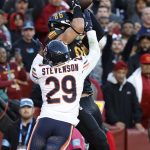The Cubs have been hounding teams for pitchers since Theo Epstein took over as President of Operation. With the philosophy of drafting talented hitting prospects, while relying on free agency and the trade market to land a staff-ace. The formula has worked out brilliantly so far, with the Cubs adding staff stalwarts in Jon Lester and Jake Arrieta resulting in a World Series trophy. But the front office has always hinted at adding young, controllable pitching.
Using assets they had acquired over years of drafting and signing talented minor leaguers, the Cubs plan was to trade for their next ace using top tier prospects. Last season, the Cubs used their top prospect in Gleyber Torres as the key piece in the Aroldis Chapman trade. And this July, the Cubs added White Sox southpaw Jose Quintana, who was instantly seen as the Cubs future staff ace – however unfair that may be.
Quintana, since moving 30 minutes north of Guaranteed Rate Field, has been essentially exactly what the Cubs traded for….a pitcher having a somewhat sub-par season. His ERA with the White Sox was 4.49, with the Cubs it’s 4.50. He was walking 3.5 batters per nine innings with the Sox, 3.3 with the Cubs. Quintana registered a 9.4 K/9 on the south side, which has bumped up to 10.4 on the north side.
Simply put: Quintana is still the same struggling pitcher he was with the White Sox, he just plays for the Cubs.
So, What’s The Deal?
As great as Cubs twitter is, at times it can quickly become a cesspool of half-baked hot takes bashing players like the middling Quintana or the front office for trading a player like Eloy Jimenez. What people seem to forget is, before this year, Quintana was one of the most valuable assets in all of baseball. His cost-controlled contract plus his reliable consistency on the mound had some people making claims that the White Sox most valuable asset was, in fact Quintana, and not superstar ace Chris Sale.
While statements like that seem silly now, it’s not hard to create the narrative on why Jose Quintana commanded the high price tag the Cubs ended up paying. And even though the Cubs did acquire Quintana to help them now, he is also a key piece to the Cubs future. But, the results for ‘Q’ have been deflating to say the least, and it didn’t help that he had one of his best starts of the season in his debut for the Cubs.
But since then, Quintana has struggled to consistently located his pitches, leading to an inflated HR/FB rate of 14.3% and a BB/9 of 3.41 – both marks are the worst he’s ever posted. After looking through quite a bit of game tape and spending the last few days staring at advanced statistics, I’ve started to see a trend with Quintana that wasn’t an issue prior to 2017.
According to Brooks Baseball‘s HR/(FB-LD), the two pitches Quintana struggles to keep in the park are his sinker and curve ball. These are his career Saber-metrics.


Now, take a look at his 2017 numbers.


Clearly, both the sinker and curve’s HR/FB+LD increased a significant amount this season, supporting the idea that Quintana is having a hard time keeping the ball in the yard.
So, I started digging for video via Baseball Savant, trying to find anything out of the ordinary with Quintana’s sinker and curveball. While I started to watch video, I realized the bigger issue for Quintana isn’t so much the location of his secondary pitches as it is his fastball.
Quintana’s four seam fastball, while only topping at about 93 mph, is key to setting up his curveball. When Q has had success in the past, it has come from him hitting his spots, getting ahead with his fastball, while forcing hitters to have to try and put his curveball in play. Strangely, Quintana is throwing first pitch strikes at a career high rate of 67.6%, however the numbers are still so-so for Q.
What I have noticed is he is almost constantly missing his spots this season, which has lead to either big hits, or walks. And teams have started to realize his fastball command isn’t great, swinging less frequently at his pitches – more than 4% less than they did in 2016. Because of this lack of control over his fastball, Q is relying more on his sinker and curveball, both pitches that work better in succession of his fastball. Here are a few examples
His sinker never has much break, but Quintan’s sinker here just wobbles over the plate at 90 mph. In this clip, Quintana is ahead of the Indians Brandon Guyer, going with the sinker away from the power-hitting Guyer. However, he misses his spot high, and while it is out of the zone, Guyer recognizes the mistake and gets his bat head on the ball.
Here is an example of Quintana over-using is breaking balls, going to it more earlier in this count. In this clip, the Cardinals’ Randall Grichuk was waiting for Q to toss him a slow breaking ball and made the Cubs pay.
It looks like Contreras wanted that pitch a little lower, but honestly it wasn’t a bad spot for that pitch. However, Quintana’s curveball has a predictable landing spot, and when a hitter sits on the pitch, it becomes much easier to located and then drive. The pitch works much better when he is ahead in counts and has it break out of the bottom half of the zone.
Quintana’s curve has excellent break, and he usually locates the pitch well, but he has been prone to hanging the pitch. In a 3-2 count, Quintana was asked to throw a his curve low and out of the zone. Instead, he hangs the pitch in the upper half of the zone and Deven Marrero hits his 2nd home run of the night.
The frustrating thing about Q is that his curve has been extremely effective, when setup correctly, however his inability to locate his fastball is ruining any success he could have with the pitch. Like in this at bat against Mookie Betts, pay attention to the catcher’s mitt and then subsequent reaction as Betts clobbers a 3-2 meatball.
Quintana again, misses his spot, not as badly as he did to Betts above, but he allows Paul DeJong to uppercut a belt-high fastball that’s just barely off the plate and pull it into the left-center basket at Wrigley Field.
With Q’s missing command, it not only has increased the amount home runs allowed but he is also issuing more walks than ever – and Quintana is not great when batters reach . With runners on base, Quintana’s ERA jumps to 8.72, with 27 of his 57 total walks on the season coming in those situations. When Quintana walks batters, he tends to do it in bunches, which only magnifies his command issues. At this point, it’s probably more mental than anything else, but for a guy like Quintana who the Cubs need for a deep postseason run, the team should be concerned.
But even with all his struggles, Q’s track record supports the idea that the 28-year-old lefty will likely go back to his home run suppressing ways. My money is on the 5 WAR pitcher to rebound and make good on the Cubs investment, but I’m also an optimist.












